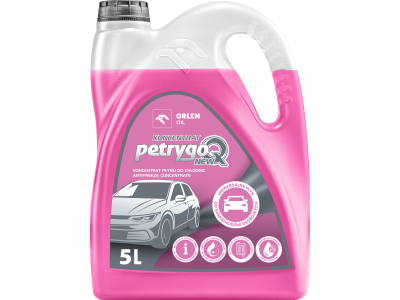PETRYGO Q
|
General features
The fluid is the latest generation of the popular Petrygo coolant manufactured since 1989. It is a ready-to-use product with freezing protection level suitable for conditions prevalent in Poland (freezing point of <-35°C). It should be used undiluted for filling (refilling) cooling systems.
Petrygo Q has been developed based on ethylene glycol (1,2-Ethanediol) and deionized water. A complete package of enhancement additives, including organic corrosion inhibitors, stabilizers, anti-foaming agents, dye and denatonium benzoate, provides effective and long-lasting protection for engine components. Petrygo Q coolant does not contain hazardous substances, such as nitrites, phosphates, amines and borates.
Application
This all-purpose product is suitable for all types of car engines, both new aluminium types and older engines. Petrygo Q coolant can be stored for 3 years from the production date. Its service life in a cooling system is minimum 3 years or 100,000 kilometres.
Standards, approvals, specifications
Conformity with standards: Polish PN-C 40007:2000, American ASTM D 3306-03
Physical and chemical properties
| Parameter | Required by standard | Typical values |
| Colour | голубой | |
| Density at 20°C [g/ml] | 1,068 - 1,080 | 1,071 |
| Ash content [% m/m] | < 2,5 | 0,45 |
| Boiling point [°C] | > 107,5 | 108,0 |
| pH | 7.5 to 11 | 10,0 |
| Alkali reserve [ml 0.1 N HCI] | > 3,0 | 6,0 |
| Crystallization point | <-35 | -36 |
| Foamability | ||
| Foam volume [ml] | <150 | 50 |
| Decay rate [s] | <5 | 2 |
| Corrosion test acc. to PN-93/C-40008/07, plate weight change [mg/plate] | Below: | |
| Copper | 10 | <3 |
| Binder | 30 | <3 |
| Brass | 10 | <3 |
| Steel | 10 | <3 |
| Cast iron | 10 | <3 |
| Aluminium | 30 | <3 |
| Corrosion test of cast aluminium alloys acc. to PN-93/C-40008/08, plate weight change [mg/cm²] | Below 1.0 | <0,2 |
| Corrosion test acc. to PN-93/C-40008/09, plate weight change [mg/plate] | Up to: | |
| Copper | 20 | <3 |
| Binder | 60 | <3 |
| Brass | 20 | <3 |
| Steel | 120 | <3 |
| Cast iron | 20 | <3 |
| Aluminium | 60 | <3 |
| NOTE: The above values of physical and chemical properties are typical values. Actual values are specified in quality certificates enclosed with each product lot. |





